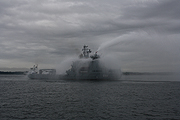Press release 2012-09-04 at 12:00
Press release by SYKE and HELCOM
|
|

|
|
Oil spill response vessel Louhi.
Image: SYKE / Jouko Pirttijärvi
|
The annual Baltic Sea pollution response exercise the Balex Delta was arranged on 28-29 August at the sea area outside Helsinki, Finland. A successful exercise was conducted in good, relatively calm weather. Had the accident been real the HELCOM fleet would have been able to collect up to 9,200 tonnes of oil during the three first days following the accident.
HELCOM member countries and the European Maritime Safety Agency (EMSA) participated with a total of 18 oil spill response vessels, supported by more than 50 smaller ships and boats, Finnish Border Guard and defence forces helicopters as well as more than 500 people from Finland and throughout the European Union. Four oil spill response vessels from Poland, Russia, Sweden and Denmark had to cancel their participation for technical reasons or due to local weather conditions.
A total of 125 observers from 14 countries and the EU Commission also attended. This year, the Balex Delta exercise received considerable financial support from the European Commission’s Directorate-General for Humanitarian Aid and Civil Protection (DG ECHO).
The exercise simulated an oil tanker catastrophe
The exercise scenario was a collision between a ro-ro ship and an oil tanker at the crossing point of the Gulf of Finland, between Tallinn and Helsinki. The imaginary oil tanker’s cargo of 100,000 tonnes of crude oil began to leak into the sea approximately 40 kilometres south of the Finnish coastline. According to the exercise scenario 15,000 tonnes of crude oil leaked into the sea starting at 3 a.m. on Monday, 27 August.
When defining the scenario, the weather was imagined to be poor, whereas it was actually clear and quite calm on both days of the exercise. The oil would have drifted into Porvoo entrance fairway by Wednesday morning, according to the imagined scenario. In the exercise, most of it was stopped off Helsinki, before reaching the archipelago.
Smooth cooperation between ships
- This year, the exercise was larger than ever. Cooperation between the ships at sea was smooth. To protect the coastline, one-metre-high oil spill containment booms from the municipalities were deployed east of Helsinki, on a five-kilometre stretch of coast. A similar length of state-owned heavier booms were deployed to prevent oil from drifting into the inner archipelago, says Kalervo Jolma, Senior Engineer of the Finnish Environment Institute, in charge of this pollution response operation.
The favourable weather conditions permitted the testing of all of the intended technical equipment. Since the Dornier maritime surveillance aircraft was unable to participate in the exercise due to a technical problem, the number of helicopter flights was increased accordingly.
For the first time ever, during Tuesday’s national exercise booms deployed from a helicopter were tested.
Developed in Finland, the Boris2 web-based situational awareness software was used for the first time in oil spill response operations, proving a promising demo. In fact, Boris2 will be taken into operative use by all Finnish response authorities in January 2013.
Fifty volunteers from the WWF Finland cleaned the coastline of Sipoo. In addition the WWF-volunteers practiced the cleaning of oil-contaminated birds at Korkeasaari zoo and in the bird containers of Eastern Uusimaa Rescue Services. Reservists from the Navy's territorial forces took part for the first time, by charting the spread of the oil along the coastline.
- The actual combating of such a huge oil catastrophe would require a long-term effort by thousands of people, emphasised Bernt Stedt, Chairman of the HELCOM Response Group at the exercise’s debriefing.
Further information
Senior Engineer Kalervo Jolma, Finnish Environment Institute SYKE,
tel. +358 400 444 686, firstname.lastname@environment.fi
Senior Adviser, Head of Marine Pollution Response Section Heli Haapasaari, Finnish Environment Institute SYKE, tel. +358 40 179 3050, firstname.lastname@environment.fi
Chairman of HELCOM Response Group Bernt Stedt, HELCOM,
tel. +46 455 353453, firstname.lastname@coastguard.se
Professional Secretary (Maritime & Response) Hermanni Backer, HELCOM, tel. +358 46 850 9199, firstname.lastname@helcom.fi
Communications
Chief Information Officer Sirpa Pellinen, Finnish Environment Institute SYKE, tel. +358 40 740 2754, firstname.lastname@environment.fi
Information Secretary Johanna Laurila, HELCOM, tel. +358 40 523 8988, firstname.lastname@helcom.fi
Photo for media
Oil spill response vessel, Louhi, spraying itself with protective mist to allow it to sail as close to the burning vessel as possible. Image SYKE/ Jouko Pirttijärvi.